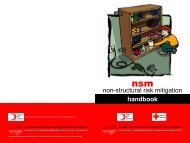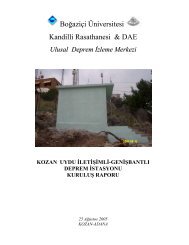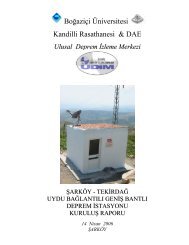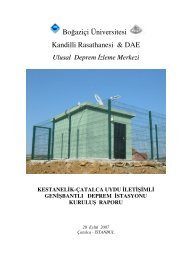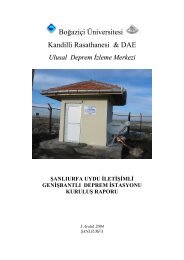ocak 2012 istanbul teknik üniversitesi fen bilimleri enstitüsü
ocak 2012 istanbul teknik üniversitesi fen bilimleri enstitüsü
ocak 2012 istanbul teknik üniversitesi fen bilimleri enstitüsü
Create successful ePaper yourself
Turn your PDF publications into a flip-book with our unique Google optimized e-Paper software.
Step 3: Mitigation of Risks: Risk mitigation includes a variety of methods from site<br />
and building investigation, strengthening, non-structural mitigation to simpler actions<br />
such as setting inflammable materials apart or maintaining the fire alarm system.<br />
Museums should start from the urgent ones and implement as far as their conditions<br />
permit. This step is an important step of the disaster and emergency management.<br />
Step 4: Organizing The Necessary İnformation and Planning for Evacuation and<br />
Response: This step gives the necessary basic information for the emergency plan. It<br />
starts with compilation of the important information of staff that will help both in<br />
forming the Incident Command System Services and during response phase. Then, a<br />
chain of communication is proposed to be developed among the staff to use in times<br />
of emergencies. Another important phase for this step is to plan for inside and<br />
outside response and make the necessary drawings ready for use in times of<br />
emergencies by attaching them to the overall plan. The inside and outside response<br />
plans are developed for emergencies that require to stay inside the building and the<br />
ones that require evacuation form the building. Plans organize areas for command,<br />
gathering, triage and first aid, temporary lavatories, storage of necessary equipment<br />
and supplies, object treatment and media debriefing. This step also encompasses<br />
making protocols to provide outside services, cooperation and mutualization.<br />
Step 5: Building An Incident Command System Within The Museum: Besides its<br />
utilization in steps 2, 3 and 4, this step is significant also for getting ready to the<br />
response phase. As a standardized system, Incident Command System is made up<br />
basically of five sections: Incident Command Post, Operations Service, Information<br />
and Planning Service, Logistics and Care Service and Finance and Administration<br />
Service.<br />
The Incident Command Post is comprised of the Incident Commander, Security<br />
Officer, Communications Officer and Press Agent. Other four services work under<br />
the supervision of the Incident Commander. Below, is the list of proposed teams for<br />
all four services that are thought to encompass action for all kinds of emergencies:<br />
Operations Service includes sub teams namely; firebrigade, search and<br />
rescue, health, security, object treatment and technical maintenance.<br />
Information and Planning Service includes sub teams of case evaluation,<br />
documentation and human resource.<br />
Logistics and Care Service contain sub teams named care, materials and<br />
equipment, internal communication, and transportation support.<br />
Finance and Administration Service is launched only on large scale disasters<br />
and involves purchase, tally, and cost and damage determination teams.<br />
The proposed plan also addresses the assigned tasks for each team.<br />
Step 6: Developing Standart Operations Procedures: These procedures are the<br />
documents that describe step by step the necessary actions for individuals or groups<br />
to take in all kinds of emergencies. The basic procedures to build on are: Drop,<br />
Cover and Hold; Evacuation; Shelter in Place.<br />
Each museum should develop its own extended procedures. Developing SOPs is a<br />
kind of training itself and having them at hand would help remind the necessary<br />
actions in times of emergencies. Once developed, they should be used and tested<br />
during exercises.<br />
xviii








